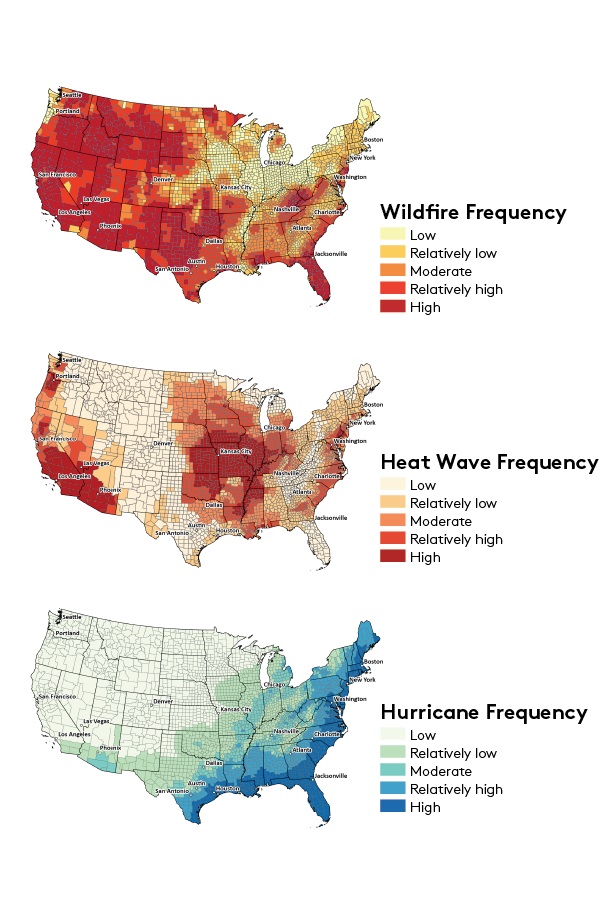A 10-year study – one of the largest ever in the United States on migration, natural disasters and climate change – shows that Americans are migrating away from places likely to have hurricanes, and into zones of wildfire danger. The study – announced by the University of Vermont on December 7, 2022 – is titled Flocking to Fire.
Mahalia Clark – an expert on sustainable agriculture in a world of climate change – led the study, which also found that people are moving away from areas of heatwaves but into areas with significant summer heat. Clark said:
These findings are concerning, because people are moving into harm’s way – into regions with wildfires and rising temperatures, which are expected to become more extreme due to climate change. … Our goal was to understand how extreme weather is influencing migration as it becomes more severe with climate change.
The researchers published their study on December 8, 2022, in the peer-reviewed journal Frontiers in Human Dynamics.
Flocking to fire
Over the last decade, the areas that have seen the most population growth include the Pacific Northwest, parts of the Southwest, Texas, Florida, and areas in the southeast that include Nashville, Atlanta and Washington D.C. The areas seeing a loss of population include the Great Plains, Midwest, and Mississippi River areas stretching into the Deep South. These areas of the south have been hard hit by hurricanes and heatwaves.
Co-author Gillian Galford of the University of Vermont explained:
These findings suggest that, for many Americans, the risks and dangers of living in hurricane zones may be starting to outweigh the benefits of life in those areas. That same tipping point has yet to happen for wildfires and rising summer heat, which have emerged as national issues more recently.
City planning could help mitigate these issues. One possibility is to discourage new development where fires are likely or difficult to fight. Another step would be to increase public awareness and preparedness in high-risk areas.
Areas of wildfire risk
When people think of wildfire dangers, they generally picture California. But one look at the wildfire map shows that this risk extends through the south, Great Plains, Florida and parts of Appalachia. As Clark said:
We hope this study will increase people’s awareness of wildfire risk. Most people think of wildfire as just a problem in the West, but wildfire now impacts large swaths of the country.

Deciding where to move
The researchers also noted that impacts of climate change and extreme weather were not deterring Americans from moving to warmer parts of the country. Clark said:
If you look where people are moving, these are some of the country’s warmest places—which are only expected to get hotter … When you’re looking for a place to live on Zillow or through real-estate agents, many don’t highlight that you’re looking at a fire-prone region, or a place where summer heat is expected to become extreme. You have to do your research.
Other factors influencing migration
The top destinations for people to move to shared a number of factors. Those factors are: warmer winters, proximity to water, moderate tree cover, moderate population density and better human development index (HDI) scores. The places people are moving away from also share some characteristics. Most notably, those are: low employment, higher income inequality, more summer humidity, heatwaves and hurricanes.
Florida is a bit of an anomaly. It remains a highly sought-after area despite hurricanes. And it’s too soon to tell if the devastation of Hurricane Ian will have any impact on migration to Florida. Clark explained:
The decision to move is a complicated and personal decision that involves weighing dozens of factors. Weighing all these factors, we see a general aversion to hurricane risk, but ultimately – as we see in Florida – it’s one factor in a person’s list of pros and cons, which can be outweighed by other preferences.
In future studies, the researchers plan to look at the impacts of remote work, house prices and the cost of living.
Bottom line: In a new study titled Flocking to Fire, Researchers found that Americans are moving away from areas of hurricanes but into places prone to wildfire danger.
Read more: Atlas of Disaster shows 90% of US counties in last decade



